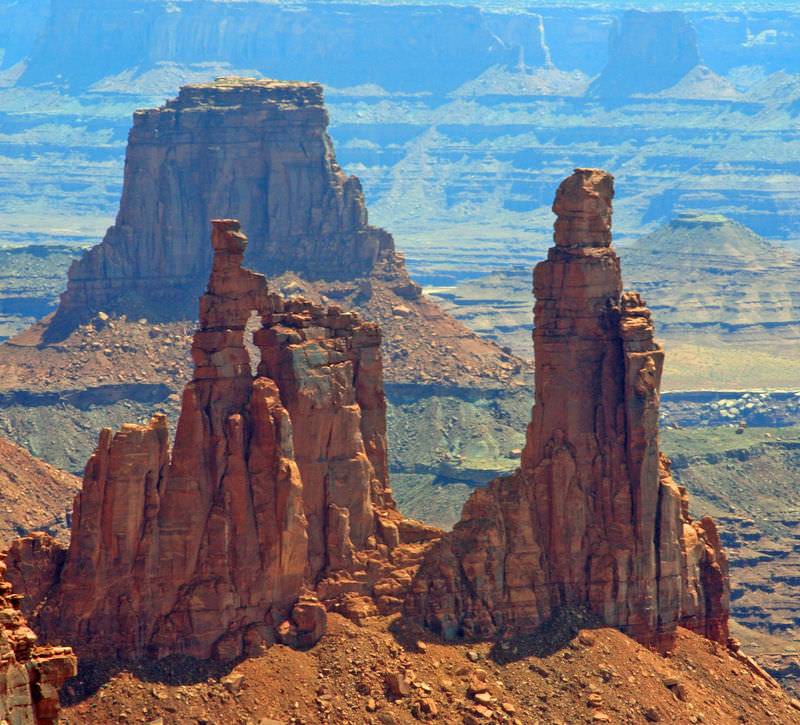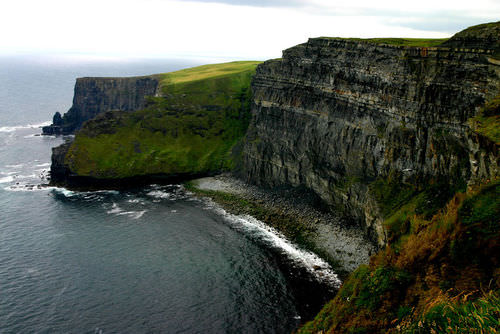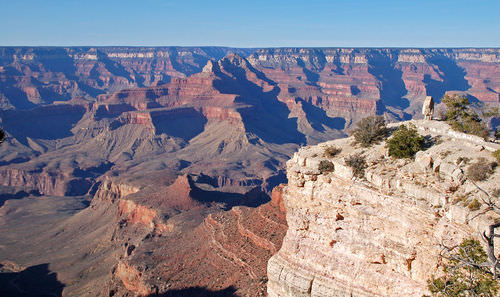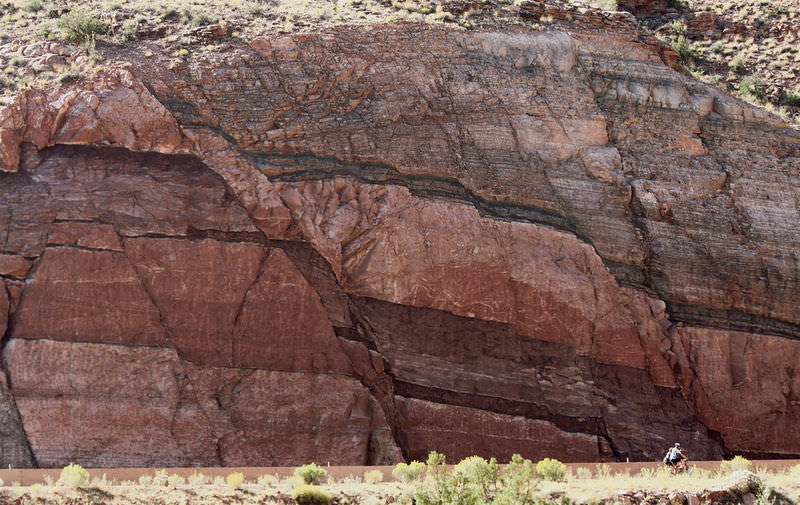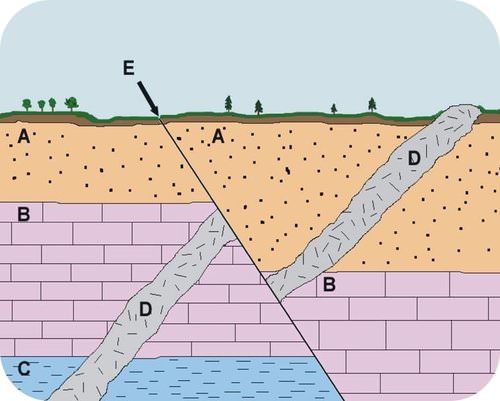READ: Relative Dating
READ: Relative Dating
The Southwestern United States is a fantastic place to see geology. The arid climate means that that the rocks are not covered by vegetation. In many places, especially the national parks, the formations are fantastic. The rocks themselves are very interesting. The principles discussed below are easily seen around the Southwest.
Relative Age Dating
Early geologists had no way to determine the absolute age of a geological material. If they didn't see it form, they couldn't know if a rock was one hundred years or 100 million years old. What they could do was determine the ages of materials relative to each other. Using sensible principles they could say whether one rock was older than another. They could also determine when a process occurred relative to those rocks.
Laws of Stratigraphy
The study of rock strata is called stratigraphy. The laws of stratigraphy can help scientists understand Earth’s past. The laws of stratigraphy are usually credited to a geologist from Denmark named Nicolas Steno. He lived in the 1600s. The laws are illustrated in the figure below; refer to the figure as you read about Steno's laws below.
(a) Original horizontality. (b) Lateral continuity. (c) Superposition.
Law of Superposition
Superposition refers to the position of rock layers and their relative ages (figure below). Relative age means age in comparison with other rocks, either younger or older. The relative ages of rocks are important for understanding Earth’s history. New rock layers are always deposited on top of existing rock layers. Therefore, deeper layers must be older than layers closer to the surface. This is the law of superposition.
Superposition. The rock layers at the bottom of this cliff are much older than those at the top. What force eroded the rocks and exposed the layers?
Law of Lateral Continuity
Rock layers extend laterally, or out to the sides. They may cover very broad areas, especially if they formed at the bottom of ancient seas. Erosion may have worn away some of the rock, but layers on either side of eroded areas will still “match up.”
The Grand Canyon is a good example of lateral continuity. You can clearly see the same rock layers on opposite sides of the canyon. The matching rock layers were deposited at the same time, so they are the same age.
Law of Original Horizontality
Sediments were deposited in ancient seas in horizontal, or flat, layers. If sedimentary rock layers are tilted, they must have moved after they were deposited.
Sedimentary rocks follow certain rules.
- Sedimentary rocks are formed with the oldest layers on the bottom and the youngest on top.
- Sediments are deposited horizontally, so sedimentary rock layers are originally horizontal, as are some volcanic rocks, such as ash falls.
- Sedimentary rock layers that are not horizontal are deformed.
Since sedimentary rocks follow these rules, they are useful for seeing the effects of stress on rocks. Sedimentary rocks that are not horizontal must have been deformed.
You can trace the deformation a rock has experienced by seeing how it differs from its original horizontal, oldest-on-bottom position. This deformation produces geologic structures such as folds, joints, and faults that are caused by stresses.
You're standing in the Grand Canyon and you see rocks like those in the figure below. Using the rules listed above, try to figure out the geologic history of the geologic column. The Grand Canyon is full mostly of sedimentary rocks, which are important for deciphering the geologic history of a region.
(a) The rocks of the Grand Canyon are like a layer cake. (b) A geologic column showing the rocks of the Grand Canyon.
In this geologic column of the Grand Canyon, the sedimentary rocks of groups 3 through 6 are still horizontal. Group 2 rocks have been tilted. Group 1 rocks are not sedimentary. The oldest layers are on the bottom and youngest are on the top.
Law of Cross-Cutting Relationships
Rock layers may have another rock cutting across them, like the igneous rock pictured below. Which rock is older? To determine this, we use the law of cross-cutting relationships. The cut rock layers are older than the rock that cuts across them.
Unconformities
Geologists can learn a lot about Earth’s history by studying sedimentary rock layers. But in some places, there’s a gap in time when no rock layers are present. A gap in the sequence of rock layers is called an unconformity.
Look at the rock layers pictured below; they show a feature called Hutton’s unconformity. The unconformity was discovered by James Hutton in the 1700s. Hutton saw that the lower rock layers are very old. The upper layers are much younger. There are no layers in between the ancient and recent layers. Hutton thought that the intermediate rock layers eroded away before the more recent rock layers were deposited.
Hutton's discovery was a very important event in geology! Hutton determined that the rocks were deposited over time. Some were eroded away. Hutton knew that deposition and erosion are very slow. He realized that for both to occur would take an extremely long time. This made him realize that Earth must be much older than people thought. This was a really big discovery! It meant there was enough time for life to evolve gradually.
Click HERE to see an animation of the formation of an unconformity.
Hutton's unconformity, in Scotland.
Determining the Relative Ages of Rocks
This photo shows rock layers and a fault—the fault is the large diagonal crack running through this rock. These features can tell us several things about relative age. Unless the rock was turned over somehow, we can assume that the layers on top are younger than the layers on the bottom. Since the fault separates the layers, we can tell that the fault occurred after all the layers were deposited.
Steno’s principles are essential for determining the relative ages of rocks and rock layers. Remember that in relative dating, scientists do not determine the exact age of a fossil or rock. They look at a sequence of rocks to try to decipher when an event occurred relative to the other events represented in that sequence. The relative age of a rock, then, is its age in comparison with other rocks. (1) Do you know which rock is older and which is younger? (2) Do you know how old the rock's layers are in years? For relative ages, you know #1 but not #2.
In some cases, it is very tricky to determine the sequence of events that leads to a certain formation. In the picture below, can you figure out what happened in what order? Write it down and then check the following paragraphs.
A geologic cross section: Sedimentary rocks (A-C), igneous intrusion (D), fault (E).
The principle of cross-cutting relationships states that a fault or intrusion is younger than the rocks that it cuts through. The fault cuts through all three sedimentary rock layers (A, B, and C) and also the intrusion (D). So the fault must be the youngest feature. The intrusion (D) cuts through the three sedimentary rock layers, so it must be younger than those layers. By the law of superposition, C is the oldest sedimentary rock, B is younger and A is still younger.
The full sequence of events is:
- Layer C formed.
- Layer B formed.
- Layer A formed.
- After layers A-B-C were present, intrusion D cut across all three.
- Fault E formed, shifting rocks A through C and intrusion D.
- Weathering and erosion created a layer of soil on top of layer A.
Summary
- Sediments are deposited horizontally. This is original horizontality.
- Sedimentary rocks are laid down horizontally.
- Rocks are laid down from oldest to youngest.
- Sedimentary rocks that are not horizontal have been deformed.
- Sedimentary rocks are very useful for deciphering the geological history of an area.
- The oldest sedimentary rocks are at the bottom of the sequence. This is the law of superposition.
- Rock layers are laterally continuous.This is the law of lateral continuity.
- Rock B cuts across rock A. Rock A must be older. This is the principle of cross-cutting relationships.
- A gap in a rock sequence is an unconformity.
- The oldest rock units lie beneath the younger ones.
- By the principle of cross-cutting relationships (and common sense), we know that something must exist before something else can cut across it.
- The history of a section of rocks can be deciphered using the principles outlined in this concept.
